The heightened triple pressures—demand contraction, supply shocks, and weakening expectations—facing the Chinese economy have been severely manifested in the employment situation, which both reflects the cyclical unemployment shocks within the macroeconomic downswing and reveals or implies long-term structural employment contradictions. While responding to short-term shocks through macroeconomic policies and active employment policy, it is especially important to prevent short-term factors from exacerbating long-term difficulties.
中国经济面临的需求收缩、供给冲击、预期转弱三重压力的增强,在就业形势上也得到了严峻的体现,既反映宏观经济下行中的周期性失业冲击,也显现或隐含长期的结构性就业矛盾。在通过宏观经济政策和积极就业政策应对短期冲击的同时,特别要防止短期因素对长期困难产生推波助澜的作用。
Since the outbreak of the COVID-19 epidemic in 2020, urban employment in China has suffered from a comparatively long shock over a sustained period. The severity of this employment shock can be appreciated based on three types of unemployment, namely structural unemployment, frictional unemployment (both of which combine to form natural unemployment), and cyclical unemployment. In February 2020, China’s surveyed urban unemployment rate reached a high of 6.2 percent, the highest level since the indicator started being officially recorded in January 2018. It has fallen since then, but assuming China’s natural unemployment rate to be 5 percent, the surveyed urban unemployment rate has been significantly higher than that level in more months since then. In April 2022, China’s surveyed urban unemployment rate increased again to 6.1 percent. Although it then fell back, it remained significantly above the natural rate.
自2020年新冠肺炎疫情暴发以来,中国城镇就业遭受持续时间较长的冲击。可以依据失业的三种类型,即结构性失业、摩擦性失业(两者合并为自然失业)以及周期性失业来认识这一就业冲击的严峻程度。2020年2月,中国城镇调查失业率达到6.2%的高位,系2018年1月该指标正式记录以来的最高水平。此后虽然有所回落,但是,如果假设5%为中国的自然失业率的话,那时以来在更多的月份里,城镇调查失业率显著高于该水平。2022年4月,中国城镇调查失业率再次提高到6.1%,之后虽然回落,但保持在显著高于自然失业率的水平上。
I. Labor market balance and imbalances
一、劳动力市场的平衡与不平衡
In recent years, China’s population figures have been constantly altering people’s perceptions. Data from the seventh census in 2020 revealed for the first time that the total fertility rate was already at the extremely low level of 1.3, and that natural population growth was on a sharp deceleration trend. Data from the National Bureau of Statistics in 2021 showed that the natural population growth rate had fallen to 0.034 percent, and the latest UN projections for 2022 suggest that China’s population will peak this year. As the population reaches its peak and enters negative growth, population aging will also deepen, and the rate of decline in the working-age population will accelerate. It is worth pointing out that this change does not signal any easing of employment contradictions, but instead marks the end of a period of relative ease in China’s employment situation. Based on the fact that the aggregate contradictions in employment have given way to structural contradictions over the past decade or so, one can expect that structural and frictional contradictions in the labor market will become more prominent in the future. This can be understood mainly by observing three change factors.
近年来,中国的人口数据不断刷新人们的认知。2020年第七次人口普查数据,首次揭示总和生育率已经处于1.3这一极低水平,人口自然增长处于急剧减速的趋势;2021年国家统计局数据显示,人口自然增长率已经降到0.34‰;联合国2022年最新预测表明,这一年中国人口将达到峰值。随着人口达到峰值并转入负增长,人口老龄化也将进一步加深,劳动年龄人口减少的速度加快。值得指出的是,这一变化不仅不意味着就业矛盾的任何缓解,反而标志着中国就业形势相对宽松的时期已经结束。在过去十余年就业的总量矛盾让位于结构性矛盾的基础上,可以预期今后劳动力市场的结构性和摩擦性矛盾将更为突出。这主要可以通过观察三个变化因素来理解。
First, the share of both young workers and older workers in the working age population will increase for a limited period of time. According to UN population projections, the share of the relatively young (16-24 years old) in China’s total working-age (16-64 years old) population is expected to increase from 14.8 percent in 2022 to 17.0 percent in 2035. At the same time, the share of the older population (46-64 years old) will increase from 40.4 percent to 43.1 percent, and the share of the population between 25 and 45 years old will fall from 44.7 percent to 39.9 percent (see Figure 1). Given that the new additions to the labor force lack employment experience and face greater difficulty in matching skills, and the difficulty of adapting the skills of older workers to the needs of the changing industrial structure, the structural and frictional difficulties in employment will increase significantly. From a longer-term perspective, in the context of negative population growth, there will be a further slowdown in growth from new additions to the labor force, especially in the numbers of highly educated graduates of various kinds, leading to a lower rate of improvement in the human capital endowment of the labor stock, thereby increasing the difficulty of labor market matching.
首先,在一个有限的时间段里,青年劳动者和大龄劳动者在劳动年龄人口中的比重都将有所提高。根据联合国人口预测,在中国全部16~64岁劳动年龄人口中,相对年轻的16~24岁人口占比,预计从2022年的14.8%提高到2035年的17.0%;与此同时,46~64岁人口占比从40.4%提高到43.1%,25~45岁人口占比从44.7%降低到39.9%(见图1)。鉴于新成长劳动力缺乏就业经验,在技能上面临较大的匹配困难;大龄劳动者的技能难以适应产业结构变化的需要,就业的结构性和摩擦性困难将显著加大。从更长的时间维度看,在人口负增长的背景下,新成长劳动力,特别是其中受教育程度较高的各类毕业生的数量增长进一步放慢,导致劳动力存量的人力资本禀赋改善速度降低,加大了劳动力市场匹配的难度。


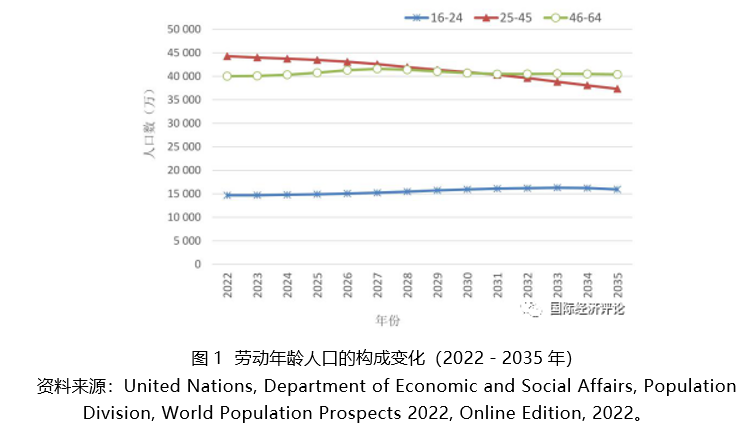 .
.Second, after experiencing the Lewis turning point from unlimited labor supply to a general shortage of labor in 2004 and the peak of the working-age population in 2010, China’s economy underwent a structural adjustment characterized mainly by the substitution of capital for labor, with a significant decline in the share of employment in labor-intensive industries and a significant weakening of employment absorption capacity, and a corresponding increase in the demand for higher-skilled labor for economic growth. Although the share of China’s manufacturing value added in GDP has long since begun to decline, manufacturing value added itself has continued to grow at a relatively fast rate, with a nominal average annual growth rate of 11.5 percent over the period 2004-2019. Employment in urban manufacturing work units grew at an average annual rate of only 1.5 percent over the same period, and has been in negative growth since 2013. If one argues that (national) manufacturing value added and (urban work unit) manufacturing employment are not consistent in terms of the scope of coverage and methods, a complementary proof can be provided by the most representative data on the employment of (local and outgoing) migrant workers within employment outside of urban work units. The share of manufacturing in migrant worker employment has been on a consistent downward trend since 2008, decreasing by 10.1 percentage points over the period 2008-2021.
其次,在2004年经历劳动力从无限供给到普遍短缺的刘易斯转折点,以及在2010年经历劳动年龄人口峰值之后,中国经济发生了以资本替代劳动为主要特征的结构调整,劳动密集型产业的就业比重显著下降,就业吸纳能力也明显减弱,经济增长对更高技能劳动力的需求相应提高。虽然中国制造业增加值占国内生产总值的比重早已开始下降,但是,制造业增加值本身仍然保持较快增长,2004-2019年期间年均名义增长率为11.5%,同期制造业的城镇单位就业年均增长率仅为1.5%,而且从2013年以来处于负增长。如果说(全国)制造业增加值与(城镇单位)制造业就业在口径范围上不尽一致的话,可以用在城镇单位外就业中最具有代表性的(本地和外出)农民工就业数据作一个补充性证明。2008年以来农民工的制造业就业比重始终处于下降的趋势,在2008-2021年期间,该比重降低了10.1个百分点。
Finally, one of the main manifestations of the negative macroeconomic effects of the COVID-19 epidemic is its impact on employment, especially informal employment. Both in manufacturing and in services, frontline jobs have seen a wave of layoffs and dismissals. Experience shows that when the macroeconomy undergoes a shock, factors are generated on both the supply and demand sides of employment that make employment suffer permanent losses. On one hand, periods of marked economic downturn are often also times of creative destruction, and industrial restructuring and employment substitution, which are long-term trends, will accelerate and occur earlier under conditions of increased pressure. On the other hand, older workers, especially migrant workers as well as some flexibly employed people, will exit the labor market at that point, and even those who are still looking for work may find it difficult to return to the labor market in the long run. Therefore, a large portion of the jobs lost to the epidemic and its economic impact cannot be expected to be regained.
最后,新冠肺炎疫情对宏观经济产生的负面影响,主要表现之一就是对就业特别是非正规就业的冲击。无论是在制造业还是在服务业,一线岗位都经历了下岗或裁员潮。经验表明,在宏观经济遭遇冲击的情况下,在就业岗位的供给和需求两侧,都产生使得就业遭受永久性损失的因素。一方面,经济明显下行时期往往也是创造性破坏的时刻,作为长期趋势的产业结构调整和就业替代,在压力加大的条件下会加速并提前发生;另一方面,年龄偏大的劳动者特别是其中的农民工,以及一些灵活就业人员,会从此退出劳动力市场,即便是那些仍有就业意愿的劳动者,也可能长期难以回到劳动力市场。因此,受疫情及其经济冲击损失的就业岗位,有很大的部分不能指望失而复得。
Based on China’s stage of development and the patterns that pertain to that stage, the basic trend of economic growth will be a gradual deceleration, and thus the demand for labor will tend to decrease. At the same time, a deceleration in economic growth due to a decline in the potential growth rate is also the result of the aging of the population, and the reduction of the working-age population in particular. This endogeneity determines that labor supply and demand are balanced in the aggregate, and that overall, China no longer faces total employment pressure. However, China will also be in the most dramatic period of development in terms of the progress and application of technology, and of structural change in industry. In the course of the new technological revolution and the industrial revolution it is leading, an asymmetry between the destruction of old jobs and the creation of new jobs will inevitably arise. That asymmetry will be expressed most prominently where workers who lose their jobs do not have the human capital required for newly created jobs, leading to a mismatch between the supply and demand of skills. Looking at the nature of the new technological revolution, the speed of change is so fast that traditional mechanisms for human capital cultivation are hard-pressed to match it, and quantitatively speaking, job creation often fails to fully offset job destruction. This will be manifested as structural unemployment, or the phenomenon of withdrawal from the labor market due to chronic employment difficulties arising from skill shortages.
根据中国所处的发展阶段及其相关规律,经济增长的基本趋势将是逐渐减速,因而对劳动力的需求趋于减少。同时,潜在增长率降低导致的经济增长减速,也是人口老龄化特别是劳动年龄人口减少的结果。这种内生性决定了劳动力的供给与需求在总量上是平衡的,总体而言中国不再面临就业总量的压力。然而,中国也将处于科技进步与运用,以及产业结构变化最急剧的发展时期。在新技术革命及其引领的产业革命过程中,必然会产生在破坏旧岗位和创造新岗位之间的不对称,突出表现在失去岗位的职工并不具备新创岗位所要求的人力资本,导致技能供需之间的不匹配。从新一轮科技革命的性质来看,其变化速度之快,传统的人力资本培养机制难以与之匹配,因此,岗位创造在数量上常常难以弥补岗位破坏。这将表现为结构性失业,或因长期面对技能不足的就业困难而退出劳动力市场的现象。
In the period since 2010, in which the contradiction in aggregate employment has given way to structural difficulties, China’s labor market has also exhibited a coexistence of job destruction and job creation. From the perspective of employment flows, job destruction is no doubt an increasingly important factor in the decline of net job creation (the difference between job creation and job destruction), in addition to the negative growth of the working-age population. Based on this logical relationship, although there is no corresponding data on job creation and job destruction in the existing employment statistics, it is still possible to make a less rigorous data comparison and roughly observe the quantitative relationship between the two. In Figure 2, the “new urban jobs” reported in official statistics is used as a proxy for new job creation. This indicator only records the number of new jobs created and does not subtract the number of jobs lost, so it is not a concept of net job creation. Consequently, new market players or start-ups, which emerge in huge numbers every day, are the main source of such new jobs or job creation. In addition, the “net gain” in employment shown in the graph is the net gain in jobs at the end of the year, obtained by subtracting the previous year’s total employment from the total employment at the end of the year, which can be seen as the net gain in overall employment.
在2010年以来就业的总量矛盾让位于结构性困难的时期,中国的劳动力市场也表现出就业破坏和就业创造并存的局面。从就业流量的角度看,就业破坏无非就是在劳动年龄人口负增长因素之外,净增就业(就业创造与就业破坏之差)趋于减少的一个愈益重要的因素。根据这个逻辑关系,虽然现有的就业统计中没有关于就业创造与就业破坏的对应数据,但是仍然可以做一个不那么严格的数据比较,粗略观察两者之间的数量关系。在图2中,把官方统计中报告的“城镇新增就业”作为新创造就业岗位的代理指标。由于该指标仅仅记录了新创岗位数,并没有减去损失的岗位数,所以并不是一个净增就业的概念。因此,每日里以巨大量级涌现的新增市场主体或新创企业,是这种新增就业或就业创造的主要源泉。另外,图中展示的“净增”就业,系年底就业总量减去上一年就业总量得出的净增岗位数,可以看作是总体就业的净增量。
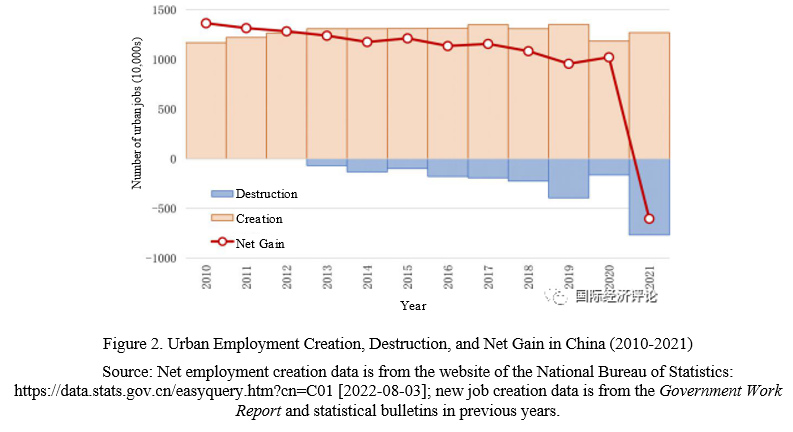

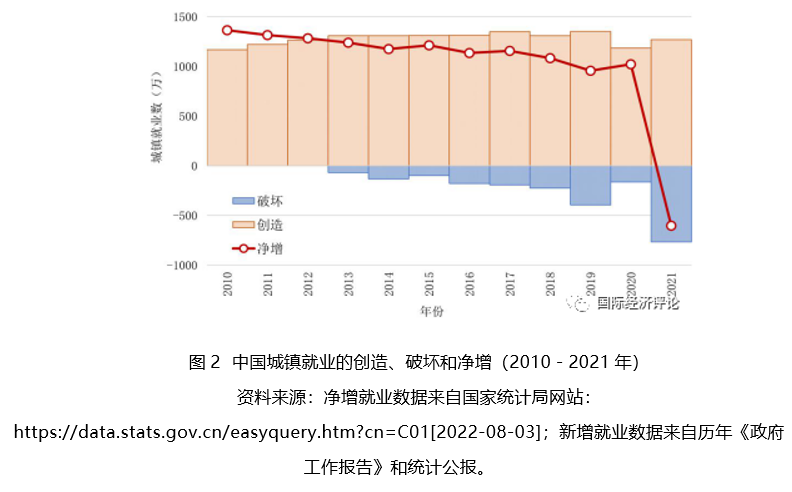

Under conditions of absolute reductions in the working-age population, the reason why there is still a net increase of urban employment every year is mainly because the rural labor force is still being transferred on a certain scale to non-agricultural industries every year, and that is increasingly covered by urban employment statistics. From official data, we can obtain the number of jobs “created” and the “net gain” in the number of jobs, and the difference between them is the number of jobs “destroyed,” which is expressed as layoffs, unemployment, etc. The difference between the two is the number of “destroyed” jobs, which is represented by layoffs, unemployment and other reasons for withdrawal from the labor market. In 2019, for example, the officially reported number of new urban jobs was 11.86 million, while the net increase in jobs reflected in the records of the statistical system was 10.22 million, meaning that 1.64 million jobs were destroyed that year. It is worth noting that the number of jobs “destroyed” is likely to be grossly underestimated because the “net gain” figure includes factors such as changes in statistical coverage and methods, for example the gradual inclusion of informal employment such as migrant employment in urban employment statistics.
在劳动年龄人口绝对减少的条件下,之所以每年城镇就业仍有净增,主要是因为每年仍有一定规模的农村劳动力转移到非农产业,且越来越多地被城镇就业统计所覆盖。从官方发布的数据中,可以得到岗位“创造”数和岗位“净增”数,两者之间的差额即为被“破坏”的岗位数,表现为下岗、失业等各种原因造成的退出劳动力市场。以2019年为例,官方正式报告的城镇新增就业数为1186万,而在统计系统记录中反映的净增就业数为1022万,意味着这一年有164万岗位被破坏。值得指出的是,由于“净增”数据包含了统计口径改变的因素,例如,农民工就业等非正规就业逐渐被纳入城镇就业统计,因此,就业“破坏”的数量很可能被严重低估了。
The concepts and data used in the discussion of job creation and job destruction here are in the sense of flows, and do not involve the number of unemployed or the unemployment rate as point-in-time data, i.e., the registered urban unemployment rate (number of unemployed) and the surveyed urban unemployment rate published annually by the National Bureau of Statistics are not taken into account. Admittedly, unemployment should be considered an important element in job creation and job destruction. However, the analysis here suffers in reality from inconsistent data coverage and methods. For example, the registered urban unemployment rate for 2019 and 2020 was 3.6 percent and 4.2 percent, respectively, and the number of registered unemployed was 9.45 million and 11.6 million, respectively. If we work backwards according to the numbers and rates, we can see that the denominator for calculating the registered unemployment rate, which is the so-called “sum of the number of employed persons and the number of registered unemployed persons at the end of the period,” was 262.5 million and 276.19 million, respectively, which is only 58.0 percent and 59.7 percent of the number of urban jobs in those years. That is to say, on one hand, the scope of registered unemployment statistics is much lower than the actual urban economically active population, and as for the surveyed urban unemployment rate, only the ratio but never the number has been published so far; on the other hand, the stock data on which calculations of the net increase in urban employment are based is not directly related to it. Therefore, when considering flow concepts such as job destruction and job creation, the number of unemployed can be taken as a constant and assumed to be relatively stable.
这里讨论的就业创造和就业破坏,所用概念和数据均是在流量的意义上,而没有涉及作为时点数据的失业人数和失业率,即国家统计局每年公布的城镇登记失业率(人数)和城镇调查失业率均未考虑在内。诚然,在讨论就业创造和就业破坏时,失业应该作为一个重要的内容。然而,这里的分析现实存在着数据口径不一致的问题。例如,2019年和2020年城镇登记失业率分别为3.6%和4.2%,登记失业人数分别为945万和1160万。按照人数和比率倒推的话,可知计算登记失业率的分母即所谓“期末从业人员与期末实有登记失业人数之和”,分别为26250万和27619万,仅为当年城镇就业数的58.0%和59.7%。也就是说,一方面,登记失业的统计对象范围远远低于实际城镇经济活动人口,至于城镇调查失业率,迄今只有比率而从未公布过人数;另一方面,计算城镇就业净增时所依据的存量数据与之并不直接相关。因此,当考虑就业破坏和就业创造等流量概念时,可以把失业人数作为一个常数,假设其相对稳定。
II. Long-term rising trend in the natural unemployment rate
二、自然失业率的长期提高趋势
Under conditions of innovation-driven economic growth, both the asymmetry between job creation and job destruction and the mismatch between the supply and demand of skills in the labor market tend to aggravate structural and frictional employment difficulties, thereby driving the formation of a long-term rising trend in the natural unemployment rate. In reality, the natural unemployment rate in China’s urban areas is undergoing a process of gradual increase, and from international experience, together with the change in China’s economic development stage and the new characteristics of the labor market, the natural unemployment rate can be expected to increase further in the post-epidemic period. This judgment comes from a consideration of multiple factors. Below are listed some of the key facts that serve as the basis. In addition, trends in the natural unemployment rate are discussed, using it as a benchmark to further observe the urban unemployment rate trend and its nature (see Figure 3).
在创新驱动经济增长的条件下,就业创造与就业破坏之间的不对称,以及劳动力市场上技能的供需不匹配等现象,都具有加大结构性和摩擦性就业困难的倾向,推动形成自然失业率长期提高的趋势。现实中,中国城镇的自然失业率,正在经历一个逐渐提高的过程,并且从国际经验、中国经济发展阶段的变化以及劳动力市场新特点,可以预期自然失业率在后疫情时期将进一步提高。做出这个判断来自对多种因素的综合考虑,下面列举一些主要的事实作为依据。此外,讨论自然失业率的变化趋势,以其为基准进一步观察城镇失业率趋势及其性质(见图3)。
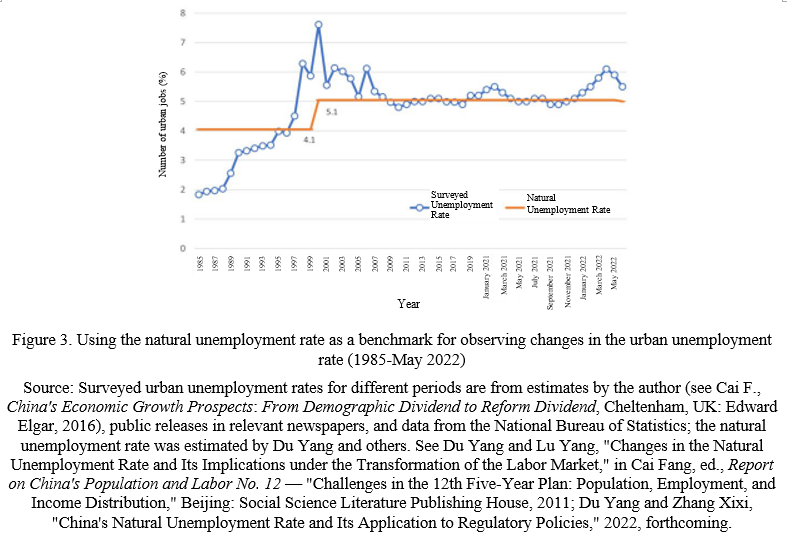

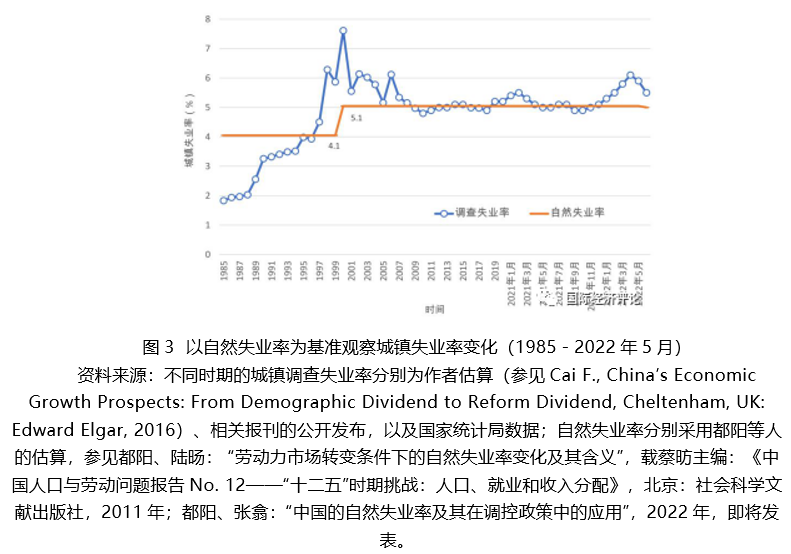

First, the results of estimation in existing studies support the judgment that the natural rate of unemployment has increased and will increase further. Theoretically and methodologically, the natural rate of unemployment, i.e., the “non-accelerating inflation rate of unemployment” (NAIRU), can be estimated by filtering out the effects of economic cyclical changes on employment. Using data from 1987-2009, Du Yang and Lu Yang estimate the natural rate of unemployment in China to be between 4.05 percent and 4.10 percent, and find that it is on an upward trend. Zeng Xiangquan and Yu Yong estimate that the natural rate of unemployment in China has fluctuated in the range of 4.8 percent to 5.6 percent since 2002. Referring to these studies and based on some other observations, in Figure 4, two levels of the natural unemployment rate, 4.1 percent and 5.1 percent, are used as benchmarks for before and after the turn of the century, respectively, to observe how the actual unemployment rate has fluctuated around them. It can also be seen in Figure 4 that the real unemployment rate has been more frequently and significantly higher than the natural rate of unemployment since the outbreak of the COVID-19 epidemic. If this situation continues, the natural rate of unemployment will take another step upward.
首先,已有研究的估算结果支持自然失业率已经有所提高并将进一步提高的判断。从理论上和方法上,自然失业率即“不引起加速通货膨胀的失业水平”(Non-accelerating Inflation Rate of Unemployment),可以通过过滤掉经济周期性波动对就业的影响估算出来。利用1987-2009年的数据,都阳和陆旸估计中国的自然失业率水平在4.05%~4.10%,并且发现其呈现上升趋势。曾湘泉和于泳估算表明,2002年之后,中国的自然失业率在4.8%~5.6%的范围内波动。参考这些研究,并依据一些其他观察,在图4中以世纪之交为界,前后分别以4.1%和5.1%两种自然失业率水平作为基准,观察实际失业率如何围绕其波动。从图4中也可以看到,新冠肺炎疫情暴发以来,实际失业率更经常和显著地高于自然失业率。如果这种情形延续下去,自然失业率将会再上一个台阶。
Second, there is tendency for employment groups that are vulnerable to structural and frictional factors, such as migrant workers, new graduates of various types, and older workers, to increase their shares of the total employment population. This labor market characteristic is the seedbed, as it were, of structural and frictional unemployment phenomena. Vulnerable groups, characterized by informal employment, are also prone to become victims of natural unemployment. Observing the diversity and heterogeneity of China’s population and worker groups, and the resulting easily differentiated characteristics, provides a micro-analytical basis for accurately understanding structural and frictional unemployment or employment difficulties. In 2021, 34.9 percent of China’s population did not live in the same place as their household registration, with the mobile population accounting for 26.6 percentage points of this total. Out of the total labor force of 780 million, some 750 million were actually employed, of which 76.4 percent were in non-farm employment and 61.6 percent were employed in urban areas. If within urban employment we take the people engaged in temporary jobs, employed people dispatched by labor companies, and those employed by market entities such as individual entrepreneurs as representative of flexible employment or informal employment, the corresponding proportion exceeds 30 percent. The total number of migrant workers in non-agricultural employment was 290 million, of which 121 million were employed in their own towns and cities and 172 million were migrant workers (133 million migrant workers were still living in cities and towns at the end of the year).
其次,易于受到结构性和摩擦性因素影响的就业群体,如农民工、各类毕业生、大龄劳动者等,在总就业人群中的比重趋于提高。这个劳动力市场特征,可谓结构性和摩擦性失业现象的温床。以非正规就业为特征的相关脆弱群体,也容易成为自然失业的受害者。观察中国人口和劳动者群体的多元化和异质性,以及由此产生的易于分化特点,为准确认识结构性和摩擦性失业或就业困难提供了微观分析基础。2021年,中国人口中34.9%的居住地与户籍所在地不一致,流动人口占据其中的26.6个百分点;在全部7.8亿劳动力中,实际就业人口为7.5亿,其中76.4%为非农就业,61.6%在城镇就业。如果把城镇就业中从事临时性工作的人群、劳务公司派遣的就业者,以及个体工商户等市场主体就业人员,作为灵活就业或非正规就业的代表,相应的比重超过30%;在非农产业就业中,农民工总数为2.9亿,其中在本乡镇就业1.21亿,外出农民工1.72亿(年末仍在城镇居住的农民工1.33亿)。
Finally, both theory and experience show that after each recession or crisis, the structural problems in the labor market tend to intensify and the natural rate of unemployment increases. Among cyclical economic changes, recessions usually imply the destruction of a part of production capacity and the elimination of corresponding enterprises from the market. Accordingly, new start-ups often play a greater role in economic recovery and hence in the recovery of production capacity. Compared to the eliminated enterprises, new start-ups represent a better production function, and thus the macroeconomic process from recession to recovery is also a reorganization of production factors, that is, a process of creative destruction in the Schumpeterian sense. Therefore, compared with the pre-recession period, the demand of enterprises for workers’ skills is significantly higher after economic recovery, which inevitably leads to some workers having difficulty adapting. The recurrence of so-called “jobless recoveries” in the U.S. recession and recovery cycles from 1992 to 2008 is a manifestation of increased natural rates of unemployment. In general, China’s future economic growth will be increasingly innovation-driven. The creative destruction mechanism will play a greater role, and the frequency of job-changing by workers will increase significantly.
最后,理论和经验均表明,每次衰退或危机之后,劳动力市场的结构性问题趋于强化,自然失业率有所提高。在经济周期性波动中,衰退通常意味着部分产能被破坏,对应的企业被淘汰出局。相应地,在经济复苏从而产能恢复的过程中,新创企业常常发挥更大的作用。相比于被淘汰的企业,新创企业代表着更好的生产函数,因而宏观经济从衰退到复苏的过程也就是生产要素的重组,即熊彼特意义上的创造性破坏过程。因此,与衰退之前相比,经济复苏后企业对劳动者的技能需求显著提高,必然导致部分劳动者难以适应。美国1992-2008年的多次衰退和复苏周期中,反复出现所谓“无就业复苏”现象,就是自然失业率提高的表现。总体来看,未来的中国经济增长越来越依靠创新驱动,创造性破坏机制将发挥更大作用,劳动者转岗的频率将显著增大。
III. Potential for fuller and higher-quality employment
三、更充分更高质量就业的潜力
While economics textbooks define full employment as a situation in which the unemployment rate is at a level that “does not cause accelerating inflation,” this is not always the case in reality. On one hand, the so-called “natural unemployment” in macroeconomics or labor economics is not “natural.” That is to say, “natural” states of unemployment, and even some withdrawal from the labor market, can be avoided. On the other hand, the natural rate of unemployment is not always statistically certain and precise, and mechanical estimation under a priori assumptions may not reflect a complex and changing reality, and may even sometimes cause distortion of reality and thus misguided policies. In general, while an overly low natural rate of unemployment may send a distorted signal of insufficient incentives to invest in human capital, when the natural rate of unemployment is overly high but is not estimated, and it therefore does not attract due policy attention, the result may be underutilization of labor resources, affecting both the improvement of people’s livelihood and causing a loss of resource allocation efficiency.
虽然经济学教科书把失业率处于“不引起加速通货膨胀”水平的情形定义为充分就业,现实中并非总是如此。一方面,宏观经济学或者劳动经济学中所谓的“自然失业”并不“自然”。也就是说,处于“自然”状态的失业现象甚至一些退出劳动力市场的情形,本来是可以避免的。另一方面,自然失业率在统计意义上并不总是确定和精准的,在先验的假设下以机械的方法进行估算,未必能够反映复杂多变的现实,甚至有时会造成对现实的扭曲从而对政策的误导。一般来说,过低的自然失业率固然可能传递人力资本投资激励不足的扭曲信号,过高的自然失业率并且未被估算出来,因而不能引起政策应有关注的话,则会导致劳动力资源未尽利用,既影响民生的改善, 又会造成资源配置效率的损失。
Therefore, in the case of labor market shocks, macroeconomic policies need to respond to cyclical unemployment phenomena in a timely manner. At the same time, economic and social policies should be used in an integrated manner, striving to eliminate the structural and frictional factors that prevent full employment, so as to prevent the consequences of short-term shocks from becoming chronic and normalized. Under normal macroeconomic conditions where there is no cyclical unemployment phenomenon, reducing the natural rate of unemployment from all angles should be the main objective of active employment policy placed at the macro policy level. In China’s economic reality, there are still factors that have the effect of raising the natural rate of unemployment, that is, of creating “unnatural” natural unemployment. Identifying these factors and analyzing them can help to identify the right entry points for promoting labor market development and implementing active employment policy, thereby promoting the goal of fuller and higher-quality employment.
因此,在劳动力市场遭遇冲击的情况下,宏观经济政策固然需要及时地应对周期性失业现象,同时也要综合运用经济社会政策,着力消除妨碍充分就业的结构性和摩擦性因素,防止短期冲击的后果长期化和常态化。在不存在周期性失业现象的正常宏观经济条件下,从各个方面入手降低自然失业率,应该成为置于宏观政策层面的积极就业政策的主要目标。在中国的经济现实中,仍然存在一些因素,产生提高自然失业率的效果,即造成“不自然的”自然失业。找出这些因素并进行分析,有助于在推动劳动力市场发育和实施积极就业政策中抓准切入口,推动实现更充分、更高质量的就业目标。
First, employment for some groups of people does not conform to the essential meaning of “full employment.” Whether it is the surplus labor still remaining in agriculture, or people employed in low-productivity industries and the informal sector, they do not fall within the unemployment category according to survey coverage and methods. In China’s economic reality, however, there are still significant productivity differences between agricultural and non-agricultural industries, between various industries, and between different enterprises in the same industry. This situation is to a large extent caused by barriers to the flow of production factors, and in particular by structural and frictional factors in the labor market. As long as these barriers persist, the allocation of labor resources cannot reach an optimal state and full employment cannot be truly achieved. This fact tells us that active employment policy needs to be implemented in concert with industrial policy and competition policy in order to smooth the channels for the flow of production factors, especially labor.
首先,并非所有群体的就业都符合“充分就业”的本质含义。无论是农业中仍然存在的剩余劳动力,还是在低生产率行业以及非正规部门的就业,虽然按照调查口径均不属于失业的范畴。但是,在中国经济现实中,在农业和非农产业之间、各类行业之间,以及同一行业的不同企业之间,仍然存在着明显偏大的生产率差异。这种情况在很大程度上是由生产要素流动障碍造成的,特别是由劳动力市场上的结构性和摩擦性因素造成的。只要这些障碍继续存在,劳动力资源的配置就不能达到优化的状态,充分就业也就不能真正实现。这一事实启示我们,积极就业政策需要与产业政策和竞争政策协同实施,以畅通生产要素特别是劳动力的流动渠道。
Second, not all groups with employment intentions can be successfully employed through the usual procedures such as “job searching” and “training.” In reality, there are always some workers who cannot be employed by the labor market alone or even by the conventional support policies. There are two typical manifestations of this failure to achieve employment intentions. The first phenomenon is the so-called Discouraged Worker Effect, which refers to the situation where a person is unemployed for a long time and fails to find a job, so that he or she loses confidence and stops actively looking for a job. In the statistics, this is classified as “withdrawal from the labor market” rather than unemployment. Considering that the “withdrawal” of this group is not a willing choice, the U.S. Bureau of Labor Statistics also calculates corresponding unemployment indicators, such as U-6, as a supplement to the conventionally defined unemployment rate indicator (U-3). The second phenomenon is that some workers with employment intentions face greater barriers to employment than others, including high family caregiving burdens, chronic illnesses, disabilities, and advanced age. Both of these phenomena require the government to take greater supportive measures for specific groups and their special vulnerabilities.
其次,并非所有具有就业意愿的群体都可以经“寻职”和“培训”等惯常程序,顺利实现就业。现实中总是存在一部分劳动者,仅靠劳动力市场的自发作用,甚至靠常规力度的扶助政策都不足以保障其就业。这种就业意愿不能实现的典型表现有两种。第一种现象是所谓“沮丧的工人效应”(Discouraged Worker Effect),指长期处于失业状态且未能找到工作,以致失去信心不再积极寻找工作的情形,在统计中被归为“退出劳动力市场”而不是失业。考虑到这个群体的“退出”并非心甘情愿选择,美国劳动统计部门还专门计算相应的失业指标如U-6,作为常规定义下失业率指标(U-3)的补充。第二种现象是部分劳动者面临比其他人更大的就业障碍,包括家庭照料负担重、患慢性病、有残障和年龄偏大等,同时又有就业意愿。这两种情形都要求政府针对特定群体及其特殊脆弱性,采取更大力度的措施予以帮扶。
Third, not all jobs can be created by relying on the market. Due to their natural properties or changes at particular times, some economic activities have strong externalities, where social returns are greater than private returns. Spontaneous market mechanisms are not sufficient to reflect the real demand for them or to create satisfactory returns on investment and compensation for workers, thus often leading to their under-supply. Examples include: socialization of household chores through childcare, which eases burdens on families and helps stabilize the fertility rate; action on resources, the environment, and climate change that contribute to sustainable development; public health provision to improve health levels; community services to improve the quality of life; the care, assistance, and respect for the elderly that are necessary to cope with aging; and public service jobs created to stabilize employment in the event of shocks. Obviously, the creation of such jobs relies on a certain degree of policy intervention to provide additional incentives.
再次,并非所有的岗位都可以依靠市场创造出来。由于自然属性或者时点变化的影响,一些经济活动具有较强的外部性,社会收益大于私人回报,自发的市场机制不足以反映对其真实的需求,也不能形成合意的投资回报和劳动者补偿,因此常常导致供给不足。例如,有利于稳定生育率的托幼事业缓解家庭负担的家务劳动社会化,有利于可持续发展的资源环境和气候变化行动、提高健康水平的公共卫生、改善生活质量的社区服务、应对老龄化必要的养老、助老、敬老事业,以及遭遇冲击时为稳定就业而设立的公益岗位等。显而易见,这类岗位的创造有赖于一定程度的政策干预,以便提供额外的激励。
Finally, the heterogeneity of the workforce creates complexity in labor market matching. The new additions to the labor force graduating from schools of all levels and kinds are often plagued by structural and frictional unemployment, resulting in a “paradox” wherein the higher the education level, the lower the degree of matching. While this certainly reveals the employment difficulties that university graduates face, it tends to be misleading as to directions for educational development. On one hand, as education levels rise, human capital specialization increases and generality decreases, or the singularity of skills increases, the range of employment choices narrows accordingly and matching becomes more difficult. On the other hand, the structural upgrading of industries also places higher requirements on human capital, and the direct signals are demands for specialized skills. In order to understand these two regular phenomena taken together, one must perceive that, under conditions of constant technological change and industry structural change, demands for skills are not only ever-changing but also rapidly changing. This creates a market failure, as both job seekers and employers are unable to accurately identify and judge labor market demands on an individual level. It is clear that only governments can coordinate education, industry, and employment to break this labor market matching paradox.
最后,劳动者群体的异质性导致劳动力市场匹配的复杂性。从各级各类学校毕业的新成长劳动力,往往遭遇较大的结构性和摩擦性失业困扰,以致产生一个学历越高匹配度越低的“悖论”,这固然揭示了高校毕业生面临的就业困难,却易于产生对教育发展方向的误导。一方面,随着教育阶段的提升,人力资本的专用性提高、通用性降低,或技能的单一性增强,就业选择范围相应变窄,匹配难度也就增大。另一方面,产业结构的升级换代也对人力资本提出更高的需求,直接信号就是对技能的专门化需求。把这两种具有规律性的现象统一起来理解,就是要看到,在技术和产业结构千变万化的情况下,对技能的需求不仅是日新月异的,同时也是瞬息万变的。这就造成一个市场失灵的现象,因为就准确辨析和判断劳动力市场需求来说,无论是寻职者还是雇主,均存在个体层面的力有不逮。可见,只有政府才能把教育、产业和就业协调起来,从而打破这个劳动力市场的匹配悖论。
IV. Conclusions and policy implications
四、结语和政策含义
International experience shows that when there is a shock to economic growth, if the policy response is not timely and appropriate, the shock will leave a “scar” that affects subsequent development, producing a so-called “hysteresis effect” that makes the post-recovery norm in economic growth less favorable than before. Similarly, if the response to cyclical unemployment is not timely, comprehensive, and appropriate, or if it relies only on macroeconomic stimulus without simultaneously addressing the structural and frictional contradictions in the labor market, it may leave a “scar” on the employment issue, such that the post-recovery labor market operates with a higher natural rate of unemployment. Although the fundamentals of China’s economy have not changed due to the temporary macroeconomic downturn, the labor market landscape may indeed change as the population enters an era of negative growth and economic growth faces new challenges.
国际经验表明,在经济增长遭遇周期性冲击的情况下,如果政策应对不及时、不恰当,便会留下影响后续发展的“伤痕”(Scar),产生所谓的“磁滞效应”(Hysteresis),使复苏之后的经济增长处于一个较前更为不利的常态下。与此类似,如果应对周期性失业的举措不及时、不全面和不对症,或者仅仅依靠宏观经济刺激作用,而不能同时解决劳动力市场的结构性和摩擦性矛盾,那么可能在就业问题上会留下“伤痕”,使经济复苏后的劳动力市场在更高的自然失业率下运行。虽然中国经济的基本面未因暂时的宏观经济下行而改变,但是随着人口进入负增长时代,经济增长面临崭新挑战,劳动力市场格局确有可能发生变化。
This change can be recognized from both the supply side and the demand side. First, the rapid decline in the working-age population will bring greater supply-side constraints, and the input-driven growth model will become increasingly hard to sustain. Shifting the engine of growth to an innovation-driven track requires creating an environment of creative destruction and increasing productivity through the selection of winners and elimination of losers. Correspondingly, employers’ demands for workers’ skills will increase significantly, the difficulty of skill-matching in the labor market will increase, and much higher precision will be required in the targeting of active employment policy and public employment services. Second, a declining and more deeply aging population means that demand-side factors, especially consumption, are increasingly becoming normalized constraints on economic growth. Since the employment status of workers affects household consumption and aggregate demand through its impact on people’s incomes, active employment policy needs to have a demand-side macro perspective. For example, the surveyed unemployment rate of the urban population aged 16-24 in June 2022 was as high as 19.3 percent, which was 4.29 times higher than the surveyed unemployment rate of the population aged 25-59 (4.5 percent) in the same period. Since the consumption of the former age group is significantly higher than that of the latter, as the sample survey data show that the arithmetic mean of consumption expenditure of the urban population aged 16-24 is 1.45 times higher than that of the population aged 25-59, the high youth unemployment rate resulting from the macroeconomic cycle will become a serious drag on macroeconomic recovery.
这种变化可以分别从供给侧和需求侧认识。首先,劳动年龄人口迅速减少带来更大的供给侧制约,投入驱动型的增长模式愈益难以为继。把增长引擎转到创新驱动的轨道上,要求营造创造性破坏的环境,通过优胜劣汰提高生产率。与此对应,雇主对劳动者技能的需求大幅度提高,劳动力市场技能匹配的难度将增大,对积极就业政策的针对性和公共就业服务的精准度要求也大大提高。其次,人口减少和更深度老龄化意味着需求侧因素特别是消费,日益成为经济增长的常态化制约。由于劳动者的就业状况通过对居民收入的影响,进而影响家庭消费和社会总需求,因此,积极就业政策需要具备需求侧的宏观视角。例如,2022年6月城镇16~24岁人口的调查失业率高达19.3%,为同期25~59岁人口调查失业率(4.5%)的4.29倍。由于前一年龄组的消费显著高于后一年龄组,如抽样调查数据显示,城镇16~24岁人口消费支出的算术平均值是25~59岁人口的1.45倍,作为宏观经济周期性结果的青年失业率高企,将会成为宏观经济复苏的严重堵点。
Therefore, there is still a lot of room for policy and institutional operations to deal with the current unemployment problem, which is of a short-term shock nature, especially with regard to managing cyclical unemployment, which needs to focus on preventing labor market shocks from lasting too long and damaging specific groups of workers too much, thereby causing cyclical and transitory factors to turn into long-term and structural factors. As the epidemic is gradually brought under control, production and consumption activities will return to their regular tracks, economic growth potential can be released as soon as possible, and cyclical unemployment is expected to gradually disappear. However, since unemployment is not determined by cyclical factors alone, active employment policy should devote greater efforts toward eliminating structural and frictional difficulties and reducing the natural rate of unemployment. Economic development is a combination of medium- and long-term growth and cyclical changes, subject to the constraints of growth potential on the supply side and the effects of cyclical fluctuations on the demand side. Accordingly, active employment policy faces multiple tasks at the same time, including promoting long-term employment, managing natural unemployment and helping with employment difficulties under normal conditions, managing cyclical unemployment when shocks are encountered, and constructing labor market institutions.
因此,应对当前具有短期冲击性质的失业问题,尚有很大的政策和制度操作空间,特别是在治理周期性失业方面,需着眼于防止劳动力市场冲击持续过久、对特定劳动者群体损伤过大,从而使周期性的、过渡性的因素转变为长期的、结构性的因素。随着疫情逐步得到控制,生产和消费活动将恢复到常规轨道上,经济增长潜力可以尽快得到释放,周期性失业现象预期逐渐消失。然而,既然失业并非仅由周期性因素决定,因此,积极就业政策应该以更大的力度消除结构性和摩擦性困难,降低自然失业率。经济发展是中长期增长与周期性变动的统一,受到供给侧增长潜力的制约和需求侧周期波动的影响。相应地,积极就业政策同时面临长期的就业促进、常态下的自然失业治理和就业困难扶助、遭遇冲击时的周期失业治理,以及劳动力市场制度建设等诸项任务。
Placing priority policies for employment at the macro policy level requires that these tasks be organically combined, making the policy measures stronger and more effective. First, job creation should correspond to long-term economic growth. In order to expand the number of new jobs, a sustained flow of new market players should be maintained by improving the business environment. To address the coexistence of job destruction and job creation, and in response to the mismatch between the demand for human capital and its cultivation, as well as the resulting asynchrony between employment expansion and economic growth, the government should pay more attention to promoting the effective linking of education, employment, and training. Second, the function of the labor market system should be improved and enriched. Social mechanisms for labor rights and labor-management relations determined by labor laws and regulations should be established and regulated, so that they can fully reflect the special nature of the labor factor, of which people are the vehicles, and always ensure the protection of workers in creative destruction. Third, to address structural and frictional factors in the labor market, public employment services should focus on special support for the young, elderly, and informal employment groups, so as to reduce the natural rate of unemployment. Finally, macroeconomic policies should respond to cyclical unemployment by using monetary policy tools to create an accommodative monetary environment and unconventional internal and external demand to drive growth back to the potential growth rate, and also by being more adept at using fiscal policy tools to stabilize incomes and consumption through social insurance, family subsidies, and job creation.
把就业优先政策置于宏观政策层面,要求把这些任务有机结合起来,使政策措施的力度更大、效果更明显。首先,与长期经济增长对应的就业创造。通过改善营商环境保持新增市场主体的持续流量,以扩大新增就业的数量。针对就业破坏和就业创造并存的局面,应对人力资本需求与培养之间的不匹配及其造成的就业扩大与经济增长之间的不同步,政府应更加注重促进教育、就业、培训等工作的有效衔接。其次,完善和充实劳动力市场制度功能。建立和规范劳动法规确定的有关劳动者权益和劳资关系的社会机制,使其充分体现劳动力要素以人为载体的特殊性,在创造性破坏中始终确保对劳动者的保护。再次,针对劳动力市场结构性和摩擦性因素,公共就业服务聚焦于对青年、大龄和非正规就业群体的特别扶助,降低自然失业率。最后,宏观经济政策应对周期性失业,既要使用货币政策工具创造宽松货币环境和非常规的内外需求,促使增长回归潜在增长率,还应更加擅长使用财政政策工具,通过社会保险、家庭补贴、岗位创造等手段稳定居民收入和消费。